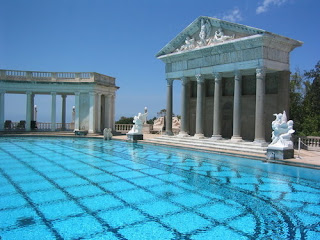Types Of Swimming Pools
A home swimming pool could be a
fantastic refuge for weary family members. It is the one place where we
all wish to be on a hot day. Swimming is a calming exercise, as well as a
healthy one, for individuals of all age groups. In addition, a nicely
created swimming pool adds class as well as value to any home.
But what type of pool should you put in?
You will find numerous options to consider. Here are probably the most common options:
Swimming Pools Designs: Above Ground:
Above
ground swimming pools are the simplest to build and the cheapest to
buy, as they come as pre-made kits. They are the summer-fun answer for
those who don't wish to make the larger commitment of an in-ground
swimming pool. If you're not yet ready for a permanent structure in your
yard, then an above-ground may be the way to go.
Here are the above ground swimming pool tidbits to think about:
Quick to install: Grab a few handy neighbors and you can be hosting a pool party in just a few days.
Moveable:
Should you move, you can take your pool with you, give it to a friend
or even sell it. Or you can leave it as a gain for the next owner of
your home.
Choices: You are able to choose from
aluminum, resin or steel sidings. All 3 types have numerous benefits,
ranging from rust-resistance to average life-span. Your local dealer can
help you to weigh the pros and cons of each kind.
Affordable: Above-grounds are excellent for those searching for a fairly affordable way to provide years of backyard family entertainment.
Great for Small Lots: If
getting a back-hoe into your yard might be next-to-impossible, an
above-ground can usually be carried in a kit to your yard and set up.
Variety: Above-grounds come in several sizes and shapes, and a range of decorative wall patterns and decking choices.
Swimming Pools Designs: Below Ground:
Fiberglass:
Fiberglass
pools are built utilizing molded fiberglass, reinforced plastic.
Fiberglass pools are in ground, and can provide you years and years of
family fun and swimming pleasure. Fundamentally, a fiberglass swimming
pool is similar to a giant bathtub.
Here are fiberglass pool tidbits to think about:
Installation:
As soon as your yard has been excavated, the swimming pool is delivered
in one piece and set up. Building time is usually about two weeks.
Cost:
Fiberglass pools are usually more expensive to purchase than concrete
inground pools, but can save you money over the life of the pool. This
is simply because they usually will require fewer chemicals than
concrete pools. You also avoid upcoming replastering and liner
replacement expenses.
Shock absorbent: What
happens if the earth moves? Fiberglass has a shock-absorbing capability
that allows it to bend up to 2 feet. However, there also are new
concrete building methods that allow concrete to flex. So, it's
important to remember that if you live in an earthquake-prone region, be
certain to have your dealer explain the features and benefits of
fiberglass and concrete construction.
Maintenance:
Unlike a plaster finish, a fiberglass shell doesn't change the
chemistry of the water, so you often will use much less acid. Simply
because of the non-porous surface, you do not need to brush the pool
nearly as often as a plaster-finished concrete swimming pool. However,
you typically do not need to brush a pebble-finish concrete pool as
frequently as a plaster-finish pool, so when discussing this choice with
a dealer, be sure you're comparing apples to apples.
Vinyl:
Vinyl
lined swimming pools would be the cheapest kinds of in ground styles
you can get, even though you will need to have the liner replaced every
ten years or so.
A vinyl-liner swimming pool typically is shipped
from the manufacturer in kit form. After excavation, the panel walls are
bolted or fastened together and supported at the bottom by a concrete
footing. The vinyl liner is spread over the interior of the swimming
pool and covers the excavated floor and paneled walls. It is connected
to the top of the panel walls by a vinyl rib at the outside edge of the
liner. Be sure to ask your liners usually have to be replaced in your
area of the country. Construction time for vinyl-liner swimming pools is
usually one to three weeks.

.JPG)







